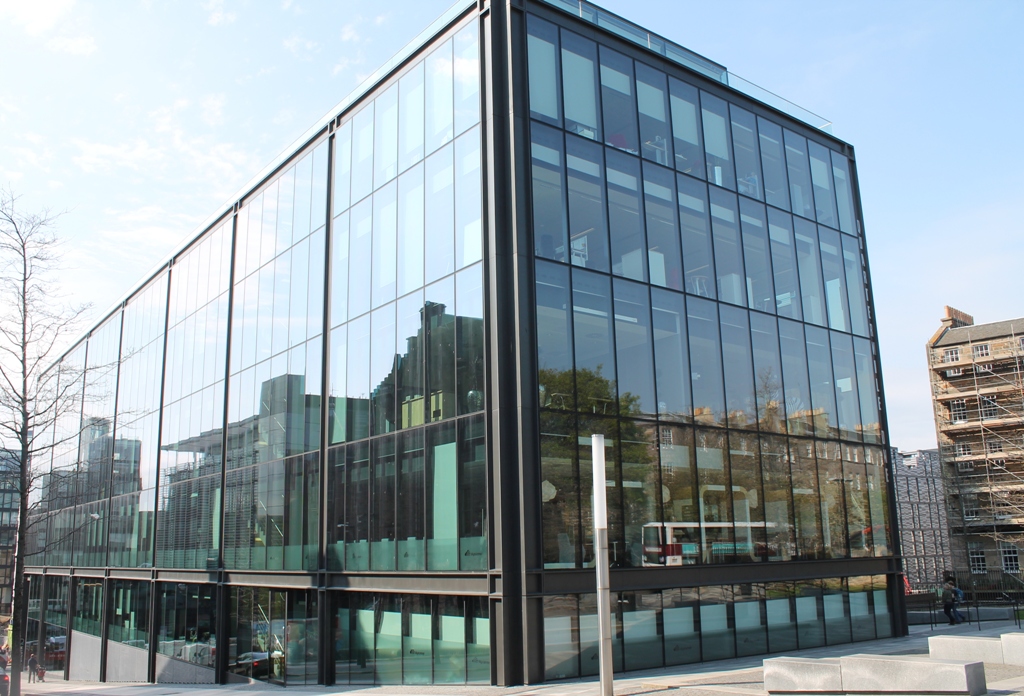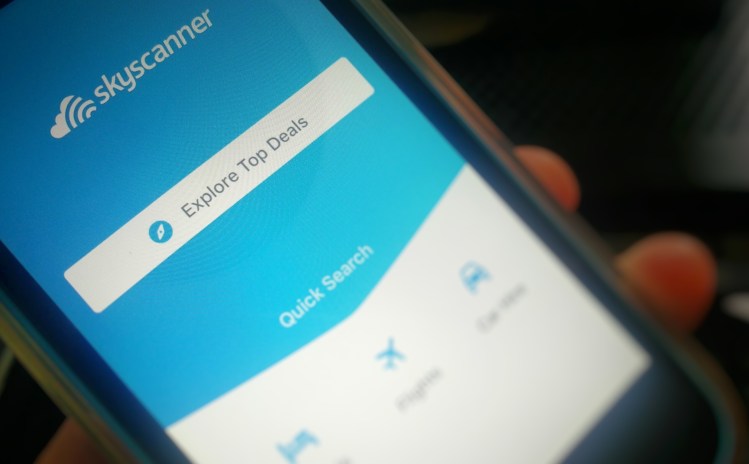It’s been a busy year for travel search giant Skyscanner. In the wake of the Scottish company’s first substantial funding round in January — a whopping $192 million that valued the 13-year-old firm at $1.6 billion, according to reports — the Edinburgh-based tech giant was catapulted into the limelight as the latest U.K. company to achieve “unicorn” status, a term as much derided as it is coveted.

Above: Skyscanner: All-in-one
In the months since, Skyscanner has embraced automated customer support with the launch of a new Facebook Messenger bot. But perhaps one of the biggest recent changes, from a product perspective, happened this week, when the company merged its flagship flight-search app with its existing standalone apps for hotels and car hire, creating a truly multi-talented travel booking app.
VentureBeat recently caught up with Skyscanner cofounder and CEO Gareth Williams at the company’s headquarters in the heart of Edinburgh to probe him about where the company’s at and where things could go from here.
Coming to America
By way of a quick recap, Skyscanner was founded out of Scotland in 2003 and has emerged as one of Europe’s biggest flight search engines, by traffic. In fact, it’s one of the world’s largest — claiming 50 million monthly users. Though Europe represents somewhere in the region of 60 percent of its user-base, Skyscanner claims 700 employees across Europe, Asia, and North America, and it has a growing global footprint.
The company is now doubling down on key regions where it has yet to see the level of traction it has in Europe, and one of those is North America.
Skyscanner is seeing a 100 percent year-on-year growth in visitors in the U.S., according to Williams, though no specific numbers were divulged. Williams recently asked the company’s chief financial officer (CFO), Shane Corstorphine, to move out to the firm’s base in Miami (an outpost opened in 2013) to perform a general management (GM) role, something that Williams expects will lead to “quite a lot of change” coming up.
So why the focus on America now?
“The U.S. has never not been a focus area, but it’s true to say market penetration is not as high in the Americas as it is in Europe and APAC,” he said. “But it’s growing pretty quickly.”
While many tech firms elect to have their U.S. headquarters in San Francisco or New York, Skyscanner chose Miami for a number of strategic reasons. One of those is that Skyscanner isn’t solely focused on cracking the U.S., it’s taking a more holistic approach that targets the whole continent, from Argentina through to Canada.
Given that Miami is a key Hispanic hub and a major U.S. city, Skyscanner’s decision to base its U.S. HQ there makes sense. “It’s a combination of applicability to the U.S. market, but also applicability to South America,” said Williams.
As we saw with the recent Facebook Messenger chatbot launch and the consolidation of Skyscanner’s main travel-search apps, the company is continuing to invest heavily in its product. Williams says that the company’s goal is to be “ten times better” than the competition and to let its product do the talking. “I think as product plans play out, I’ve a lot of hope that that’s going to magnify the organic growth in the U.S.,” he said. “So we’ll take that approach rather than a huge brand-building approach to growth in the U.S.”
Many tech companies seek to infiltrate the U.S. as a first major market, then they have the whole world to conquer after that. Skyscanner is doing things in reverse, which perhaps isn’t so surprising given that it’s a European company. But Williams reckons this works to the company’s advantage in terms of having a global mindset from an early stage.
“I think one of the potential advantages that European internet companies have is the earlier addressing of the internationalization of their service,” he said. “Because the U.S. market is so large, many U.S.-based companies will address the U.S. market for a long time until they run out of headroom. Being number one in the U.K., at a much earlier stage you are tempted to say, ‘What about France, what about Germany, and what about Asia?.'”
Global outlook
This international outlook also plays out in other ways — when a company is looking to enter other markets, it’s in a better position to scrutinize companies operating in those countries and learn from them. “We want to learn from many of the ecommerce developments and the user-behavior that you witness in China, Korea, India, Japan and so on,” added Williams. “I think U.S. companies are less aware of some of the developments there.”
It has long been understood that the mighty Facebook has drawn inspiration from some of the tech companies in Asia — WeChat, for example — particularly as part of Facebook’s mission to transform Messenger into a platform. After all, if a simple messenger app in China can permeate multiple industries, from banking and gaming through to ecommerce and beyond, why wouldn’t that approach work in Western markets, too?
Williams says that the same philosophy has been part of his own thinking for a while. “Alibaba’s T-Mall and WeChat have been an inspiration for several years for me,” he said. “Even in a period when most of the rest of the world kind of viewed them as clone kings. The Messenger platform wasn’t a surprise for us; we had a candidate product and were talking with Facebook within 7 days of the API being released. And the reason was that we’ve been working with others, such as Line and others, in advance.”
Skyscanner has been growing in Asia over the past few years, and the company has forged some great alliances in its mission to conquer the continent. For example, back in 2012, Skyscanner partnered with China’s largest search engine, Baidu, to become its official search partner for international flights. And when Skyscanner announced its mammoth $192 million raise back in January, a couple of notable investors stood out — Yahoo Japan and the Malaysian Government.
“The Yahoo Japan investment was because they got to know us — we set up a joint venture with them to target our product to the Japanese traveling market,” said Williams. “The reason for that really is because they have a huge user-base in Japan. It is formally a joint venture, but it follows our model of having geographically dispersed product and engineering-centered teams. Working off a core platform, many of the things the engineers work on will make their way back into the global platform, and equally, anything we work on globally is also provided to the Japanese travelers.”
And what about the Malaysian Government’s investment arm?
“Their investment strategy is very strong in APAC,” continued Williams. “In terms of contacts, advice, partnerships, that certainly gives capability to us, given that the investors in the most recent round are represented by Europe, the Americas, and APAC.”
Don’t call us a unicorn
It’s worth noting here that Skyscanner shares its global HQ in central Edinburgh with a number of companies, one of which is another tech giant you may have heard of.
Fantasy sports behemoth FanDuel has its main engineering hub at Quartermile, a couple of floors up from Skyscanner, but it’s pretty much the polar opposite of Skyscanner in terms of market focus — FanDuel may have been founded and built out of Edinburgh, but its entire target market has so far been North America.

Above: Quartermile, Edinburgh: Home to 2 unicorns
FanDuel is also another “unicorn” company — its $275 million raise last year cemented its $1 billion-plus valuation. As with a growing number of entrepreneurs and figures from within the tech industry, Williams isn’t keen on being called a “unicorn.”
“We’re not a unicorn because we’re profitable,” he said, in reference to the notion that a company’s valuation often does not reflect its actual viability as a business. Instead, Williams reminded us about another cute animal analogy that better describes Skyscanner: Real Actual Business Building Interesting Tech (RABBIT).
“There are companies that have been around for a couple of years and received eye-popping valuations, and they may become the next Facebook or they might not,” said Williams. “Ours is based on ten years of consistent growth, generally speaking between 40 percent and 100 percent, and that’s been achieved organically. The amount of capital we’ve spent in order to get to where we are is $6 million of investors’ cash.”
So what about the recent $192 million cash injection? According to Williams, they haven’t touched a penny of it yet. But he did stress that the level of funding a company receives should not determine its true value.
“I’ve never felt that funding in a private company is the point at which a valuation is determined,” he said. “I’ve never felt that funding is part of the entrepreneurial journey. It can be an acceleration of entrepreneurial goals, but funding rounds in and of themselves are almost the opposite of entrepreneurial, which can be defined as setting out to achieve a goal which you currently do not have the resources to achieve. So that’s really bootstrapping.”
Skyscanner may have bootstrapped for much of its 13-year history, foregoing substantial outside investment for money made of its own volition, but the fact is it now has a chunky wad of cash at its disposal, and this will go some way toward helping the company crack America. So how positive is Williams about that mission? “I don’t think it will be an instant thing, but the direction that we’re heading is really good,” he said. “If we keep 100 percent year-on-year growth in North America, we will achieve great things over there.”


